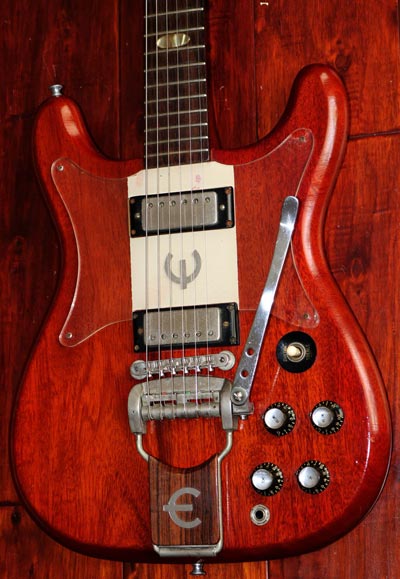
 The Epiphone Crestwood Custom from the 1964 Epiphone catalogue
The Epiphone Crestwood Custom from the 1964 Epiphone catalogue
The first two Epiphone solid body guitars were manufactured at Gibson's Kalamazoo plant, in Michigan, USA. The SB332 Crestwood, and SB533 Coronet launched in 1959, using Gibson-built bodies and (usually) necks, fitted with a mix of standard Gibson parts, and old Epiphone parts, from when production was in Philadelphia, before Epiphone was bought by Gibson parent company CMI. These included the 'New York' pickups and white pointer control knobs. As they were used up, they were replaced with mini humbuckers and bell knobs respectively.
Bodies and necks were mahogany, whilst the fretboard was rosewood; the Epiphone solid-body range could be directly correlated to the Gibson SG range sharing many features; hardware, pickup configurations, body and neck woods, construction and controls. They were all made side by side, so this is not surprising. The Crestwood Custom corresponds to the SG Standard in terms of build, pickup configuration (although the Epiphone uses smaller humbuckers) and ornamentation - despite the fact that this model precedes the SG Standard by two years. The Crestwood did have some interesting features of it's own - naturally the mini humbuckers were used in several Epiphone models, but the clear plexiglass scratchplate of early examples is quite unique and a very distinctive feature.
 1962 Epiphone Crestwood Custom - image courtesy Garys Classic Guitars
1962 Epiphone Crestwood Custom - image courtesy Garys Classic Guitars
60s Epiphones were not regarded as second class Gibsons, demonstrated by the fact that the Crestwood Custom actually costs more than the SG Standard, $340 vs $305 (1/10/66 pricing). It also sold less in its entire run than the Gibson sold year by year. In total 1349 Crestwood / Crestwood Custom's were shipped over ten years.
Most 1960s Epiphone solid guitars used the same body shape - double cutaway, and initially symmetrical. In 1963 the entire series was redesigned; the overall body dimensions didn't change, however the lower cutaway was shortened slightly, and the old two-sided headstock changed to a single sided 'batwing' style. The Crestwood got a very new scratchplate design - white (or tortoiseshell on White guitars) replacing the old clear plexiglass version, and with the controls mounted into them, rather than directly into the guitar's body. The three-way pickup selector switch was relocated to the far end of the guitar. Around this time a similar model with the same second Crestwood body style, and an additional pickup, the Crestwood Deluxe was added to the line, shipping through to 1969.
1961 'guitars, basses, amplifiers' catalogue
“The professional player who wants the finest quality in a solid body guitar finds it in the Epiphone Crestwood Custom.”
1962 'guitars, basses, amplifiers' catalogue
“A double cutaway model with two adjustable polepiece pickups, it offers superb tone, perfect response, fast easy action, low frets, plus solid body durability”
1964 full line catalogue
This is the first catalogue to show the new-style asymmetrical Crestwood, with six-a-side tuners
1966 full line catalogue
“Epiphone is proud to present solid body instruments that offer the depth, the sharp treble, the biting tone and the virility that all guitarists seek from a solid body instrument”
Shipping figures for the Crestwood Custom indicate that 1349 Customs were produced in total. The figures below are as available from the factory, but may actually be a little misleading. Shipping figures prior to 1966 do not separate by finish; each years total is for all Cherry, White and custom colour guitars. Beyond 1966, Cherry guitars are separated from other finishes. It would be incorrect to assume Cherry finishes began in 1966, when in fact it was the only finish listed as available throughout the period of production. White was added as a finish option in 1962.
| 1959 | 1960 | 1961 | 1962 | 1963 | 1964 | 1965 | 1966 | 1967 | 1968 | 1969 | |
| SB332 | 43 | 45 | 135 | 259 | 134 | 291 | 229 | 15 | 9 | ||
| SB332 Cherry | 132 | 33 | 9 | 15 |
In the 1970s the Epiphone (now Japanese manufactured, Matsumoku) launched a new guitar dubbed Crestwood, however with a model number ET278. This was a double pickup instrument with a similar body shape, but a bolt-on neck, and very different hardware.
$860
$799
$790
€9990
£5337
€799